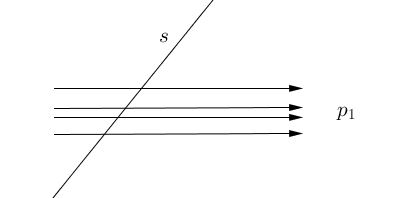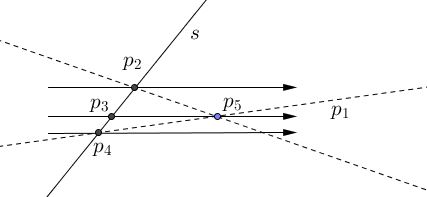(Để tạm đây)
Source: http://www.cut-the-knot.org/proofs/SylvesterGallai.shtml
The Sylvester Problem has been posed by James Joseph Sylvester in 1893 in Educational Times:
Let n given points have the property that the line joining any two of them passes through a third point of the set. Must the n points all lie on one line?
T. Gallai’s proof has been outlined by P. Erdös in his submission of the problem to The American Mathematical Monthly in 1943.
Solution
Given the set Π of noncollinear points, consider the set of lines Σ that pass through at least two points of Π. Such lines are said to be connecting. Among the connecting lines, those that pass through exactly two points of Π are called ordinary.
Choose any point p1∈Π. If p1 lies on an ordinary line we are done, so we may assume that p1 lies on no ordinary line. Project p1 to infinity and consider the set of connecting lines containing p1. These lines are all parallel to each other, and each contains p1 and at least two other points of Π. Any connecting line not through p1 forms an angle with the parallel lines; let s be a connecting line (not through p1) which forms the smallest such angle:

Then s must be ordinary! For suppose s were to contain three (or more) points of Π, say, p2, p3, p4 named so that p3 is between p2 and p4:

The connecting line through p3 and p1 (being not ordinary) would contain a third point of Π, say p5, and now either the line p2p5 or the line p4p5 would form a smaller angle with the parallel lines than does s.
References
- P. Borwein, W. O. J. Moser, A survey of Sylvester’s problem and its generalizations, Aequationes Mathematicae 40 (1990) 111 – 135
- P. Erdös, R. Steinberg, Problem 4065 [1943, 65], The American Mathematical Monthly, Vol. 51, No. 3 (Mar., 1944), pp. 169-171
- J. J. Sylvester, Educational Times, Mathematical Question 11851, vol. 59 (1893), p. 98
